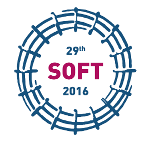Speaker
Michal Kordac
(TEO)
Description
In a prospect of future fusion power plants construction, diferent concepts of tritium breeding blankets are being developed within the EUROfusion breeding blanket work package. Three main concepts using Pb-17Li as breeder, the HCLL (Helium Cooled Lithium Lead), WCLL (Water Cooled Lithium Lead) nad DCLL (Dual Coolant Lithium Lead) are developped as candidate technologies for european DEMO facility.
Helium is a by product of tritium breeding by lithium decomposition. Compared to tritium, its solubility is several orders of magnitude lower. Previous experiments have shown, that bubble formation within the PbLi alloy during irradiation may occur and suggested they pose a serious threat for breeding blanket concepts based on liquid PbLi. An important aspect of the helium bubble formation is tritium desorption into the gas phase formed within the liquid metal. This part of the tritium will be removed along with the helium and will not enter the Tritium Extraction System.
To assess the extent of the helium gas release, a simplified model of a single sector of the breeding blanket had been developped and local helium production rates have been calculated. Based on current physical properties and recent development of the blanket geometry, it is possible to estimate the local gas bubble release rate within each module, the gas bubble release profiles along the PbLi conduits and the gas composition.
Co-authors
Kamil Wichterle
(Department of chemistry, Technical University of Ostrava, 17. listopadu 2172/15, 708 00 Ostrava, Czech Republic)
Lukas Kosek
(TEO, Centrum výzkumu Řež, Husinec - Řež, Czech Republic)
Michal Kordac
(TEO, Centrum výzkumu Řež, Husinec - Řež, Czech Republic;Dept. of Chemical Engineering, University of Chemical Technology, Technická 5, Praha, Czech Republic)

